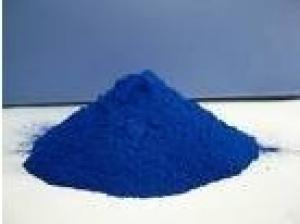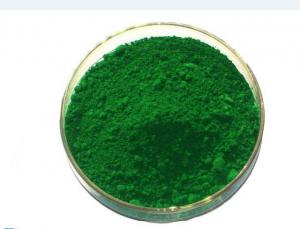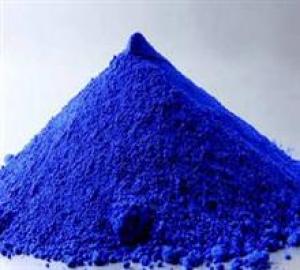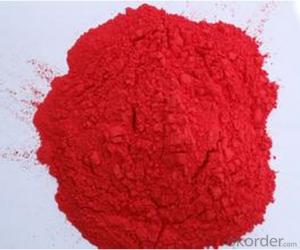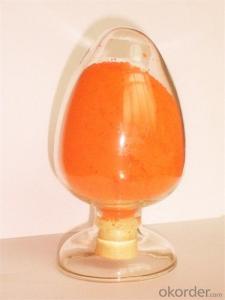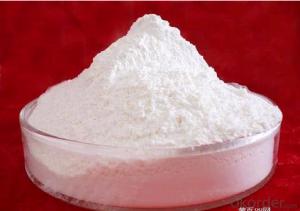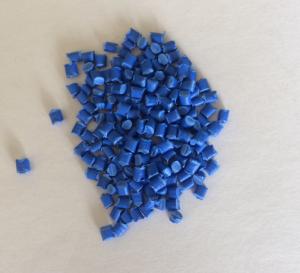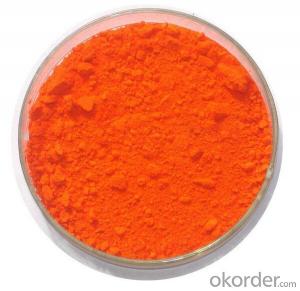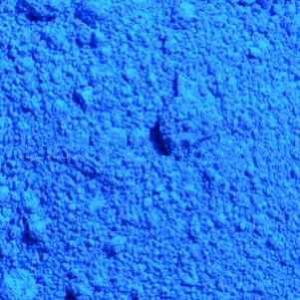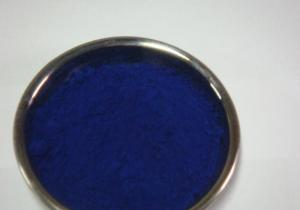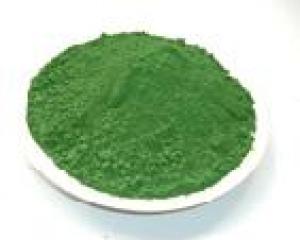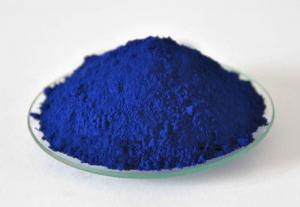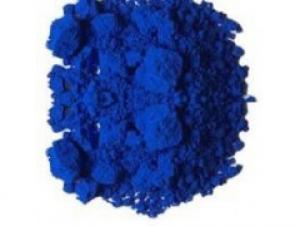Cadmium Red Pigment Pigment Organic Powder
- Loading Port:
- Tianjin
- Payment Terms:
- TT OR LC
- Min Order Qty:
- 500 kg
- Supply Capability:
- 6000000 kg/month
OKorder Service Pledge
OKorder Financial Service
You Might Also Like
Specifications Cadmium Red:
- Heat resistance: 400~900'C
- Light fastness: Grade 7
- Weather resistance: Grade 5
Cadmium Red Pigment
(More requirements, please contact us freely)
Cadmium Red Information:
Chemical name: Cadmium Red Pigment
Color Index Name: Pigment Red 108
C.I. No. : 77202
CAS No. : 58339-34-7
Physical Form: Red Powder
Crystal Pattern: Spinel Pattern
Cadmium Red Chemical Composition:
CdS.CdSe / CdS.HgS
CdS.CdSe.BaSO4 / CdS.HgS.BaSO4
Characteristic of Cadmium Red:
Red Powder, more or less, non-solube in water, alkali, organic solvents, slightly solube in diluted hydrochloric acid, solube in concentrated acid and Emits virulent gas H2Se and H2S. This product is non-flammable, non-corrosiveness, non-explosion hazard.
Applications Cadmium Red:
Cadmium Red is ideal red pigments for applications of enamelware and glass industry. Cadmium Red can be widely used in applications of plastics, masterbatches, ceramics, coatings, rubber, leather, artist colors as well as construction materials.
Cadmium Red have better color durability than Cadmium Yellow, are suitable for coloring outdoor products, such as automobile coatings and high grade baking varnish. Our Cadmium Red is almost suitable for all resins and plastics colors. Includes: ABS Plastics, POM, ammonium aldehyde, fiuoro-plactics, nylon, polyamide, polycarbonate, polyethylene, polypropylene, polystyrene, epoxy, PUR Polyurethane, UP Unseturated polyester, organic glass (PMMA), crude rubber and silicone rubber, etc.
Cadmium Red Main Technical Data:
Index Name | Specification |
Light Fastness (Grade) 1-8 | 7 |
Weahther Fastness (Grade) 1-5 | 5 |
Residues on 400 mesh seive % | ≤0.1 |
Oil Absorption g/100g | 16-23 |
Density g/m3 | 4.7-5.1 |
Water-soluble material % | ≤0.2 |
Moisture % | ≤0.2 |
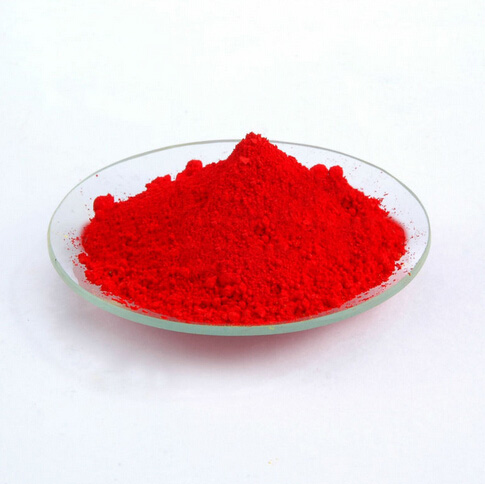
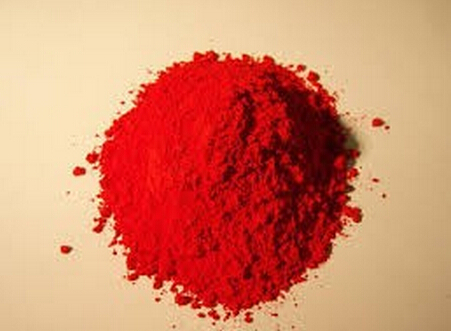
- Q: do all leaves extract contain the same pigments??why?
- Plants okorder /... Plants have classes of pigments that act as adjuncts to the chloroplast's chlorophyll, in several ways. Some are accessory pigments that broaden the range of absorbed light. These pigments are found in the light gathering arrays in chloroplasts. They also alter the color of the leaf depending on what specific pigments it has to gather light energy and that determines what is reflected (green is the basic reflected spectra but is might be yellowish or bluish green). The major accessory class of pigments, the carotenoids, collect light in the red to yellow wavelengths chlorophyll a can’t, then the carotenoids transfer the energy to chlorophyll a to process. Among the carotenoids are the xanthophylls that provide UV protection for the light gathering centers of the chloroplast. Plants adapt to situations and some just have fewer chloroplasts so have less chlorophyll and absorb less of the light. In low light situations they need fewer so variegated plants are possible. This reduced chlorophyll level allows small amounts of other pigments like the yellow pigment xanthophyll to show up.
- Q: can the pigment know as Chinese purple form a matter wave in certain circumstances?
- Peaceful demonstrations, which are the sorts urge by governments, are just a way of letting the public let off steam safely without achieving anything. It is most convenient for them - every one has a jolly time, a bit of bantering, and we all go back to the status quo. Just like the House, a lot of empty debates, and the government just goes ahead and does what it wants. The public is beginning to become aware of the severe limitations of democracy as it is practised in the west. There are times, as the government claims, it has to do what has to be done, even though the actions may be 'unpopular', meaning they are not supported by the majority, and therefore undemocratic. Thus, we have supposedly democratic governments doing undemocratic things (and we accuse other countries with different systems of being undemocratic!). In such situations where democratic governments are acting undemocratically, the public surely has a right to resort to actions other than the ballot box (denied them anyway), or futile gestures. The government is supposed to represent majority will in our system; where it ceases to do so, it has lost its mandate, and, should arguable be replaced before the election comes round.
- Q: a question on my photosynthesis test review...=_=
- they absorb light of a particular wavelength (the reason they are green). The energy from the light is transferred to the pigment in the form of excited electrons within the pigment.
- Q: What are the roles and type of plant pigments?
- Pigments are able to absorb specific wavelengths of light which power photosynthesis. Chlorophyll, which is green, absorbs all wavelengths except green. Each photon excites an electron in the light harvesting complexes of a photosystem in a chlorophyll molecule, eventually producing ATPs. Other pigments will be a different color and will be able to absorb other wavelengths, maximizing energy absorbency when the sun's rays change. Pigments are chemicals inside living things that absorb certain types of light. In plants, the pigment chlorophyll in leaves absorbs sunlight for photosynthesis to work, where the energy comes from. Chlorophyll absorbs all light except green, which is reflected. That's why most plants are green...
- Q: We see pigments everywhere in products. They make a variety of things we see today. Where does it come from? Do they actually take a red rose pedal, grind the color and designate it as the color red?
- Basically, it's an aqueous solution with an affinity to a specific substrate. Usually requires a mordant (a binding agent for specific fibers, usually a polyvalent metal ion). Dyes appear to be colored because they absorb some wavelengths of light more than others. In contrast with a dye, a pigment generally is insoluble, and has no affinity for the substrate. Some dyes can be precipitated with an inert salt to produce a lake pigment, and based on the salt used they could be aluminum lake, calcium lake or barium lake pigments. Natural dyes include things like; berries, roots, berries, bark, leaves, and wood, fungi, and lichens. There are also synthetic dyes the most famous (and the first made) being mauveine. Doing a simple Google search would bring up some different synthetic dyes, as well as the different types! (Too many to type here :-)) Hope that helped!
- Q: (After the fifteenth century)
- Pigment is color in powder form. An example is lamp black; it was first made from the soot of kerosene lamps ground fine. Binder is a substance used to hold pigment together and make it adhere; in the previous example, linseed oil would be the binder for the lamp black pigment. Vehicle is a medium acting as a solvent, carrier, or binder for paint; turpentine or mineral spirits would be a vehicle but so would linseed oil as well to help dilute the paint and help it cover a large area. Hope that helps and thanx.
- Q: how exactly do pigments work? i know that they absorb every color except the one that we see, but what are the exact physics or whatever behind the selective absorption of the light?
- Different pigments mostly absorb different range at different wavelength of light, but plant -as I know- mostly containing chlorophyll does not absorb green light so we see plants as green.
- Q: what is the difference between light color and pigment colors?
- Check out the links below. They should answer any question about the properties of light. In a nutshell, the color of light is an electromagnetic radiation.that the human eye sees. The rainbow is a visual phenomenon that shows the transmission of those radiant colors. We see them all.. ,orange, yellow, green blue, indigo, violet at one time because they are being filtered through the moisture in the air. Of them all, only the primary colors are true colors.. , green and blue. The others are where the light blends together. Pigments are artificially produced things that bend light in such a way that we see a different color. A pigment reflects the available light, changes it because of its absorption property. Thats why black is both a color and the absence of color. In light, black is the combination of all colors (black absorbs all radiant light) and in pigment the absence of any color.
- Q: the absorption spectrum and the range of light reflected by each
- A okorder /... gives the spectra (Action and Absorption)
- Q: If they are not the same, then what is the difference? Please help me out here.
- Yes, tannins are pigments but they aren't really the main plant pigment. Plant pigments usually refer to photosynthetic pigments (chlorophyll, carotenoids, etc.). These photosynthetic pigments give the leaves their green color (or yellow/orange in the fall). Tannins are non-photosynthetic phytochemical (involved in plant metabolism and internal functioning), but they are also a pigment. Tannins (and lignins) are brown. This is was gives dead leaves and wood their color. Tannins also leach out of the leaves when soaked in water (same process as brewing a cup of tea). So tannins are pigments when they leach out of leaves and stain water (or other things) brown, but they are not photosynthetic plant pigments. In other words, it depends on what context you are calling a tannin a pigment. In a live plant they are not a pigment (judgment call here). In a dead leaf or when they leach out of a leaf they are a pigment.
Send your message to us
Cadmium Red Pigment Pigment Organic Powder
- Loading Port:
- Tianjin
- Payment Terms:
- TT OR LC
- Min Order Qty:
- 500 kg
- Supply Capability:
- 6000000 kg/month
OKorder Service Pledge
OKorder Financial Service
Similar products
Hot products
Hot Searches
Related keywords







